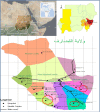" Kala-Azar is a Dishonest Disease": Community Perspectives on Access Barriers to Visceral Leishmaniasis (Kala-Azar) Diagnosis and Care in Southern Gadarif, Sudan
- PMID: 29488462
- PMCID: PMC5928836
- DOI: 10.4269/ajtmh.17-0872
" Kala-Azar is a Dishonest Disease": Community Perspectives on Access Barriers to Visceral Leishmaniasis (Kala-Azar) Diagnosis and Care in Southern Gadarif, Sudan
Abstract
Early diagnosis and treatment is the principal strategy to control visceral leishmaniasis (VL), or kala-azar in East Africa. As VL strikes remote rural, sparsely populated areas, kala-azar care might not be accessed optimally or timely. We conducted a qualitative study to explore access barriers in a longstanding kala-azar endemic area in southern Gadarif, Sudan. Former kala-azar patients or caretakers, community leaders, and health-care providers were purposively sampled and thematic data analysis was used. Our study participants revealed the multitude of difficulties faced when seeking care. The disease is well known in the area, yet misconceptions about causes and transmission persist. The care-seeking itineraries were not always straightforward: "shopping around" for treatments are common, partly linked to difficulties in diagnosing kala-azar. Kala-azar is perceived to be "hiding," requiring multiple tests and other diseases must be treated first. Negative perceptions on quality of care in the public hospitals prevail, with the unavailability of drugs or staff as the main concern. Delay to seek care remains predominantly linked to economic constraint: albeit treatment is for free, patients have to pay out of pocket for everything else, pushing families further into poverty. Despite increased efforts to tackle the disease over the years, access to quality kala-azar care in this rural Sudanese context remains problematic. The barriers explored in this study are a compelling reminder of the need to boost efforts to address these barriers.
Figures
Similar articles
-
Early diagnosis of kala-azar in Bangladesh: Findings from a population based mixed methods research informing the post-elimination era.Parasitol Int. 2021 Dec;85:102421. doi: 10.1016/j.parint.2021.102421. Epub 2021 Jul 17. Parasitol Int. 2021. PMID: 34280530
-
Kala-azar in Darfur: Evidence for indigenous transmission in Al-Malha Locality, North Darfur, western Sudan.Parasit Vectors. 2018 Mar 6;11(1):149. doi: 10.1186/s13071-018-2746-3. Parasit Vectors. 2018. PMID: 29510744 Free PMC article.
-
Intensely clustered outbreak of visceral leishmaniasis (kala-azar) in a setting of seasonal migration in a village of Bihar, India.BMC Infect Dis. 2020 Jan 6;20(1):10. doi: 10.1186/s12879-019-4719-3. BMC Infect Dis. 2020. PMID: 31906924 Free PMC article.
-
Kala-azar as an AIDS-related opportunistic infection.AIDS Patient Care STDS. 1999 Aug;13(8):459-65. doi: 10.1089/108729199318183. AIDS Patient Care STDS. 1999. PMID: 10800524 Review.
-
The epidemiology of visceral leishmaniasis in Bangladesh: prospects for improved control.Indian J Med Res. 2006 Mar;123(3):275-88. Indian J Med Res. 2006. PMID: 16778310 Review.
Cited by
-
Outdoor Residual Insecticide Spraying (ODRS), a New Approach for the Control of the Exophilic Vectors of Human Visceral Leishmaniasis: Phlebotomus orientalis in East Africa.PLoS Negl Trop Dis. 2020 Oct 20;14(10):e0008774. doi: 10.1371/journal.pntd.0008774. eCollection 2020 Oct. PLoS Negl Trop Dis. 2020. PMID: 33079934 Free PMC article.
-
"It's just a fever": Gender based barriers to care-seeking for visceral leishmaniasis in highly endemic districts of India: A qualitative study.PLoS Negl Trop Dis. 2019 Jun 27;13(6):e0007457. doi: 10.1371/journal.pntd.0007457. eCollection 2019 Jun. PLoS Negl Trop Dis. 2019. PMID: 31247011 Free PMC article.
-
Visceral Leishmaniasis (Kala-Azar): A Triumph Against a Trickster Disease.Cureus. 2022 Jun 6;14(6):e25698. doi: 10.7759/cureus.25698. eCollection 2022 Jun. Cureus. 2022. PMID: 35812632 Free PMC article.
-
Exploring global and country-level barriers to an effective supply of leishmaniasis medicines and diagnostics in eastern Africa: a qualitative study.BMJ Open. 2019 May 30;9(5):e029141. doi: 10.1136/bmjopen-2019-029141. BMJ Open. 2019. PMID: 31152044 Free PMC article.
-
Towards the elimination of visceral leishmaniasis as a public health problem in east Africa: reflections on an enhanced control strategy and a call for action.Lancet Glob Health. 2021 Dec;9(12):e1763-e1769. doi: 10.1016/S2214-109X(21)00392-2. Lancet Glob Health. 2021. PMID: 34798033 Free PMC article. Review.
References
-
- World Health Organization , 2017. Weekly Epidemiological Record, Vol. 92. Geneva, Switzerland: World Health Organization. 557–572.
-
- World Health Organization , 2016. Global Health Observatory Available at: http://www.who.int/gho/neglected_diseases/leishmaniasis/en/. Accessed April 3, 2016.
-
- Chappuis F, Sundar S, Hailu A, Ghalib H, Rijal S, Peeling RW, Alvar J, Boelaert M, 2007. Visceral leishmaniasis: what are the needs for diagnosis, treatment and control? Nat Rev Microbiol 5: S7–S16. - PubMed
-
- Medley GF, Hollingsworth TD, Olliaro PL, Adams ER, 2015. Health-seeking behaviour, diagnostics and transmission dynamics in the control of visceral leishmaniasis in the Indian subcontinent. Nature 528: S102–S108. - PubMed
-
- Peters DH, Garg A, Bloom G, Walker DG, Brieger WR, Hafizur Rahman M, 2008. Poverty and access to health care in developing countries. Ann N Y Acad Sci 1136: 161–171. - PubMed
Publication types
MeSH terms
LinkOut - more resources
Full Text Sources
Other Literature Sources
Research Materials



